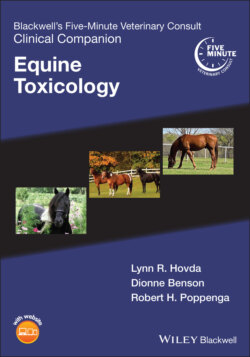Читать книгу Blackwell's Five-Minute Veterinary Consult Clinical Companion - Группа авторов - Страница 16
SIGNALMENT/HISTORY
ОглавлениеHistory and clinical signs should be kept in perspective for determining differential diagnoses while completing the necropsy.
Poisonings often affect many animals in a very short period of time and thus attract substantial public attention and interest.
Many clues can increase the suspicion of a toxic etiology. Obvious cases involve sudden onset of disease in a number of animals. Common feed or environmental conditions will further support a suspicion of an intoxication. Intoxication is also suggested in the otherwise healthy animal that is found “suddenly dead”.
However, chronic and subchronic intoxications also occur and are more challenging to diagnose because they are subtle. Sporadic mortality in a group of animals along with poor animal condition should raise suspicion of a chronic intoxication.
Other situations suggesting testing from a toxicology laboratory include drug testing in the racehorse industry, testing for nutritional adequacy (especially selenium and vitamin E status), or providing testing in suspect cases of malicious poisoning.
Reasons to suspect a poisoning:Many animals are sick with no known exposure to infectious disease.Affected individuals have been exposed recently to a new environment.There has been a recent change in feed.Recent construction activity in the environment.Recent pesticide application in the environment.Unusual weather conditions.The animal has limited feed or pasture, resulting in consumption of plants not normally consumed.An uncommon clinical condition exists.There has been a potential threat of malicious poisoning.Unexplained death(s) has/have occurred.Persistent poor health condition.
